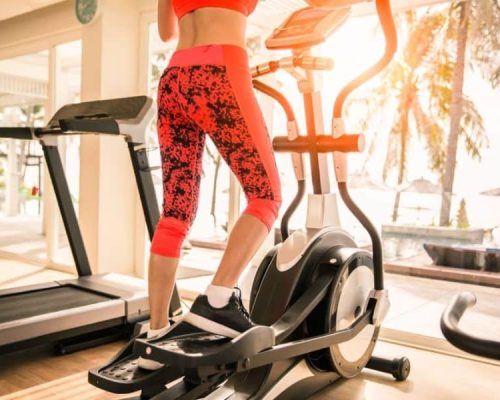Why Lifting Weights Matters for Runners
If you’re a runner eager to up your game and keep those pesky injuries at bay, lifting weights is your new best friend. By adding specific exercises to your routine, you’ll run smoother, last longer, and stay in one piece.
What You Get Out of It
When runners pump some iron, they score in many ways. You get more bang for your breath, a fancy way to say your body uses oxygen better when you run. Your legs will move more like a well-oiled machine, which comes in handy when you’re racing against the clock (Runner’s World).
Sneaking in some weightlifting helps keep your joints in check and boosts the power in those muscles of yours (NASM). Check out the handy table below to see what you stand to gain:
| Perk | What’s in It for You |
|---|---|
| Oxygen Efficiency | Your body gets better at using oxygen |
| Coordination | Smoother, more efficient strides |
| Joint Support | Stronger joints means fewer aches |
| Muscle Power | More strength and staying power for long distances |
Dodging Damage
Keeping your body happy and healthy is one of the big wins with strength training. By giving your muscles and tissues a bit of love, you sidestep injuries that love to creep up during your runs (Runner’s World).
When you lift, your body absorbs the pounding of your feet hitting the ground, saving your joints from feeling like they’ve been run over by a truck. A strong core and legs mean better posture and fewer annoying issues like shin pain and IT band trouble.
Runners often face muscle imbalances that can lead to nags and injuries. Regular strength sessions can even things out and keep you ready to rock your runs (Runner’s World).
Want more on specific moves? Take a peek at our guides about strength training exercises and the best strength training routines.
Adding weights to your workout isn’t just about lifting. It’s about keeping you on the run, staying fit, shedding a few pounds, and feeling healthier all around.
Essential Strength Training Exercises
Recommended Exercises
So, you’re a runner wanting that extra edge, huh? Strength training is your secret weapon. Not just for buffing up, it keeps you zipping along with fewer aches and pains. Here’s a fun list of moves that’ll get you there:
| Exercise | Movement | Benefits |
|---|---|---|
| Plank | Hang tight in this position | Core becomes firm like a brick, stability boost |
| Core Twist | Twist while sitting or standing; weights optional | Tweaks your side muscles, strengthens how you move side to side |
| Scorpion | Leg-swishing action down on the floor | Frees your hips, untangles muscles |
| Back Extension | Stretch on your belly like superman | Stiffens up your back, stands you tall |
| Squat to Overhead Press | One move, all muscle | Juices up your booty, thighs, and shoulders |
| Overhead Forward Lunge | Step forward with a reach | Works the tush, legs, and shoulders |
| Stability Ball Pike-Up | Roll your abs with a ball | Builds core, adds some bendiness |
| Stability Ball Leg Curl | Roll in and out with ball under feet | Fires up the hammies, strengthens knees |
| Rotational Shoulder Press | Push weights in a twisty way | Pops the shoulders, twists the tummy |
| Alternating Row | Bend over and pump some iron | Targets your mid-back, keeps you from hunching |
These routines come courtesy of Runner’s World. Go slower or quicker, heavier or lighter—it’s up to you. And hey, if you’re into keeping it casual at home, check out more in our home guide.
Targeted Muscle Groups
Getting the 411 on which muscles you’re working can tune up your running game faster than you can say “marathon.”
| Muscle Group | Key Exercises | Importance for Runners |
|---|---|---|
| Core | Plank, Core Twist, Stability Ball Pike-Up | Better balance, injury shield |
| Lower Back | Back Extension | Posture champ, holds you steady |
| Glutes | Squat to Overhead Press, Glute Bridges | Explosive hip thrusts, rocket launch your step |
| Hamstrings | Single-Leg Deadlifts, Stability Ball Leg Curl | Speedy starts, evens out muscles |
| Quadriceps | Step-Ups, Squats | Lifts knees, steady-footed when hitting the ground |
| Calves | Leg Raises | Adds spring, lightens landings |
Hip flexors and glutes bring the leggy power, especially when sprinting uphill (Nike). Need more? We’ve got more on leg muscle magic.
Quad and ham hype belong right here too. They keep your hip and knee boogying along (Nike). Got the thirst for knee and hip know-how? Slide into our bottom half basics.
Doing these moves on the regular makes you run like the wind, get you stronger, and keep those injuries away. Need more wisdom on fusing strength and running? Peep our posts on top strength moves and juggling running with gym stuff.
Adding Some Muscle to Your Running Game
Who would’ve thought that pumping iron could make you run like the wind? Yep, mixing strength training into your running routine is a surefire way to up your game. Getting the hang of when and how often to hit the weights is just as important as lacing up for your usual jog. It’s all about finding that sweet spot where you’re not wearing yourself out or slacking off.
How Often and For How Long?
According to the Physical Activity Guidelines for Americans, hitting the weights at least a couple of times a week is just the ticket. If running’s your thing, about two to three weight sessions weekly should do the trick, says the brainiacs at Runner’s World. And listen to this: just two 15–20 minute sessions are backed by the nerds at NASM as enough to see results.
| How Often | How Long? |
|---|---|
| 2–3 times every week | 15–30 minutes each session |
Keep Running Smooth
Now, if you wanna weave strength training into your running like a pro, you’ve gotta keep things balanced. Most folks in the know suggest slotting in your strength sessions on lighter training or rest days. This way, you’re not leaving yourself too knackered to go the distance.
Boosting your running economy is all about making it feel like you’re gliding rather than slogging. You’ll run faster and longer without feeling like you’re about to keel over. Plus, getting your form and technique right can save your butt from injuries. Whew! So, aim to pump iron when your feet aren’t pounding the pavement as hard, and you’ll get stronger without burning out.
For more tips and tricks, check our guides on strength training exercises for runners, home exercises, and those killer lower body workouts. Getting your routine on point not only upgrades your running but keeps you in tip-top health, warding off those pesky injuries.
Following these pointers can turn you into a running machine and level-up your fitness while keeping you on track with those running miles.
Running-Specific Benefits
Digging into how strength training hooks into your running game, you’ll see some serious gains in technique and performance. Toss in some smart exercises, and your runs might just become the stuff of legends—fewer injuries, more efficiency.
Improving Running Technique
Bringing strength training into your world can give your running form a major facelift. Pumping up those muscles, especially around your core and legs, is like giving yourself a battery pack upgrade. Your glute power, or lack thereof, can totally change how you push off the ground. It’s like running with a turbo button, especially when you’re facing those dreaded hills or sprinting like you stole something. In the words of the legends over at Nike, serious sprinters have glutes that aren’t just for show—they’re performance boosters.
Don’t skip out on core work either. Doing stuff like leg raises and back extensions bolsters your posture, keeps exhaustion at bay, and locks in that prime running style. Trust the folks over at ASICS on this one. If you’re itching for workouts to pump up your core game, take a gander at our upper body strength training exercises.
Enhancing Running Performance
Strength training doesn’t just get you ripped; it juices up your running in some serious ways. Bulk up the right muscles and you’ll find yourself speeding up, lasting longer, and feeling rock-solid.
-
Boosted Strength and Power: Moves like squats, lunges, and deadlifts will have your legs feeling like tanks, as Red Bull will tell ya. With muscles like those, each stride is pure power, slicing seconds off your race time.
-
Stamina and Smoothness: Got muscular staying power? It lets you go the distance without feeling like gravity’s your enemy. The National Academy of Sports Medicine backs this idea of using less juice with each step, saving fuel for when it counts most.
-
Strong Joints: Adding muscle around those joints turns them into reliable partners, cutting down injury risks and keeping your run game strong. For more exercises that keep the pain away, peek at our lower body strength training exercises guide.
-
Body Build: Mix strength workouts into your routine and watch the muscle grow as the fat melts away. That means sharper running mechanics and less stress on your body parts.
Work these moves into your personal routine, and watch your run better than ever. Looking for more insights and custom plans? Hit up our guide on best strength training exercises.
Safety and Guidelines
Proper Technique and Form
Safety’s your ticket to a pain-free workout, and if you’re a runner eyeing strength training, technique is your golden rule. Before you dive into lifting weights, it’s wise to get a check-up and have a tailored plan that suits your vibes (Better Health VIC). Here’s how to keep injuries at bay:
- Learn Correct Form: Doing exercises right prevents ouchies and amps up your results. Watching a pro like a physio or fitness instructor demonstrate can be a game-changer.
- Start with Lighter Weights: Lift light first to nail your form; once you’re comfy, start bumping up the weights to give your muscles a solid challenge.
- Engage Core Muscles: Keep your core tight and steady—think of it as your body’s anchor during workouts.
- Controlled Movements: No need to rush—slow and steady moves keep those joints and muscles happy.
- Focus on Breathing: Breathe out during the hard parts, breathe in during the easy going to keep your energy flowing.
Wanna dive into some top-notch exercises? Check out our guide on the best strength training exercises.
Supervision and Progression
When it comes to lifting, having someone in your corner and building up momentum slowly is key. Lack of guidance can trip up young champs and even seasoned pros (PubMed Central).
- Professional Supervision: Whether you’re fresh or a seasoned vet, getting tips from a pro ensures you’re doing things right. Supervised sessions? They boost muscle and keep injuries away, especially for the younger crowd (PubMed Central).
- Gradual Progression: Take it easy—up those weights slowly to build strength without stressing muscles.
- Adaptation Period: Your body needs a breather to adjust to new routines, so sprinkle in rest days and mix it up with different workouts.
- Monitor Your Form: Keep tabs on how you’re doing and tweak your form when necessary. Bad habits can sneakily turn into hurt later.
- Listen to Your Body: Keep an eye on how you’re feelin’. If something’s hurting, hit the pause button and huddle with a pro before jumping back in.
Looking to mix running with lifting? Peep our write-up on balancing it with running for the 411.
Stick to these tips, and you’re all set to level up your strength training game while keeping pain at bay. Always put safety first, and when in doubt, holler at a pro. Check out strength training exercises at home for more tricks and workouts to try in your space.
Muscle Groups for Runners
Ready to kick up your running game? Knowing which muscles do the heavy lifting is like having a secret weapon for your strength training exercises. Focus on those hard-working hip flexors, glutes, quads, hamstrings, and calf muscles.
Hip Flexors and Glutes
Hip flexors are your friends in need when you’re pulling that leg forward, especially when you’re sprinting or tackling hills. But after you’ve been chilling in a chair for too long, they can get tight, holding back your glute action.
And let’s talk about the glutes, the powerhouse known as the gluteus maximus that kicks in when your foot pushes off. The steeper the climb or the faster the sprint, the more they work. Check out elite sprinters – they don’t just run fast, they’ve got glutes for days (Nike).
Quadriceps and Hamstrings
Quads are all about getting your knee up and straightening it out when your foot hits—key players in sprints and uphills. They stand up to the test when you cruise downhill, handling the stress like champs (Nike).
Then you’ve got your hamstrings, pushing off the ground to get you movin’. They’re the secret sauce to acceleration, but sometimes, they take a backseat if you’re all about those quad gains (Nike).
Calf Muscles
Those calves, featuring the mighty gastrocnemius and soleus, are like your launchpads. They absorb and unleash energy like the pros they are. Picture this: zooming at 15.5 mph, your gastrocnemius can lift three times your weight, and the soleus, almost nine times! Talk about leg day.
| Muscle Group | Main Job | Things to Watch |
|---|---|---|
| Hip Flexors | Moving leg forward in swing | Can tighten if you’re a couch potato |
| Glutes | Powering that hip extension during takeoff | Vital for sprinting and hills |
| Quadriceps | Raising knee, straightening it at impact | More workload on sprints, uphills, and downhills |
| Hamstrings | Pushing off for speed | Key for acceleration; sometimes less active than quads |
| Calf Muscles | Energy absorber and propeller | Handle massive force, hefty for runners |
Shaping up these muscle groups with your strength training exercises at home can give you the edge. Dive into our guides on lower body strength training exercises and explore the best strength training exercises to up your game.










